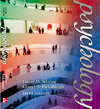|
 |  Psychology, 5/e Lester M. Sdorow,
Arcadia University
Cheryl A. Rickabaugh,
University of Redlands
Therapy
Learning ObjectivesAfter studying this chapter, you should be able to: - Summarize the history of the treatment of psychological disorders from its ancient origins to modern times, showing the connection between beliefs and treatment choice.
- Define psychoanalysis, and list and describe four psychoanalytic treatment techniques and summarize how psychodynamic therapy differs from classic psychoanalysis.
- Describe the general principle underlying all behavioral therapy and then list and describe three classical-conditioning therapies, three operant-conditioning therapies, and a social-learning therapy.
- Describe the general principle underlying all the cognitive orientation to therapy and describe the important features of rational-emotive behavior therapy and cognitive therapy.
- Describe the general distinguishing perspective of all the humanistic therapies, and then list and describe the important characteristics of two types of humanistic therapy systems.
- Describe the core concept of the social-relations orientation and the reasons for the development of the group approach to therapy, and list and describe the important features of four types of group-oriented forms of therapy.
- Describe the core concept underlying all biopsychological therapies and then list and describe the important features of and controversy surrounding both psychosurgery and ECT.
- Describe the principle underlying all drug therapies and then describe the important features of four groups of medications for the treatment of psychological disorder.
- Define deinstitutionalization and then summarize the strengths and weaknesses of this important social policy, and list and describe the three main goals of the community mental-health movement.
- Summarize the relevant issues in selecting a therapist and discuss bibliotherapy as an alternative.
- Explain what sparked the debate on the effectiveness of psychotherapy.
- Describe the issues surrounding the criteria of success in determining the effectiveness of psychotherapy and summarize the findings of the major research studies.
- Summarize what is known about the characteristics that are important factors in the effectiveness of psychotherapy.
|
|
|



 2002 McGraw-Hill Higher Education
2002 McGraw-Hill Higher Education

 2002 McGraw-Hill Higher Education
2002 McGraw-Hill Higher Education